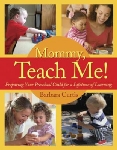This wonderful book is so good that it was one of the first preschool level resources that I added to my reviews. Barbara Curtis is a homeschooling mom of twelve and a Montessori teacher. Likely because of her own circumstances, she takes a very practical and affordable approach to create a Montessori type environment and education within the home.
In Mommy, Teach Me! Barbara first encourages parents to keep their preschoolers at home rather than sending them elsewhere. While her Christian beliefs are clearly one factor in this regard, her arguments deal more with relationships, the nature of the child, and the best ways to properly nurture and educate a child. While Barbara encourages homeschooling beyond preschool, this is a book for parents whether or not they intend to homeschool beyond preschool.
Since many parents are insecure about their own ability to teach, Barbara first addresses five key areas for parents to "maximize their teaching relationship with their child." Next, she addresses five key areas of a child's learning potential that parents must recognize and work with (rather than against) to help each develop a love for learning. This is all within the first one-third of the book. The last two-thirds consists of "exercises" or learning activities laid out in a thorough step-by-step fashion that is very easy to follow. Materials that will be needed are listed at the beginning of each exercise. Most of these exercises will be set up sort of like a portable learning center so they can be reused over and over again. There are many, many exercises for math, language arts, and science, and just a few for geography, the fine arts, and spiritual life.
The Montessori roots of Barbara's approach are clear in her stress for children to learn order and respect for learning materials as well as on the gradual building of skills and understanding through the use of hands-on activities. Authentic Montessori learning materials are very costly, but Barbara's alternatives are very sensible and practical for most families. I suspect the biggest challenge for some families will be finding an area to allocate for storage and use of the exercises.
Mommy, Teach Me! offers a refreshing alternative to a workbook or teacher/centered approach to education for young children, but it still has a structure and order to it that ensure that children make progress.
Following Barbara's advice and using her learning exercises will enable parents to provide their children with a wonderful preschool experience—one that cannot be purchased anywhere!
Note: Barbara's website features a blog with many discussion groups plus links to resources Barbara recommends at: www.MommyLife.net
Mommy, Teach Me to Read!
Mommy, Teach Me to Read! builds upon Barbara's Mommy, Teach Me! Preparing Your Preschool Child for a Lifetime of Learning, but it concentrates on language arts, and primarily upon reading. With Barbara's practical and easy-to-use methods you can teach your child to read in a fashion that is as natural as helping your child learn to speak.
Barbara begins with suggestions for early language development then moves into the heart of the book with her narrative-style instruction for introducing phonetic sounds to your preschooler. She explains how to teach them to form the letters and continues through blending phonetic sounds into words by playing games using inexpensive magnetic letters or other sets of letters. She provides lists of words for each stage of reading so you have an idea of what progression to follow. There are lists of sight words and digraph words—you will probably want to follow her suggestion to make flash cards for these words, Following Barbara's directions, you can teach your child to read at a fraction of the cost of most programs and in a manner that will help your child love to read.
Lists of recommended reading material are included, both for read-alouds and for children to use as beginning readers.
Those who have children with learning difficulties will appreciate reading about Barbara's own experience with one of her daughters, demonstrating the flexibility and usefulness of her methods with all types of children. As in Mommy, Teach Me!, Montessori methods are the foundation of Barbara's methods, but she explains how to create or find Montessori type resources that are far less expensive than authentic Montessori materials.
As I read this book, I realized that what she was describing was very much like the methods I used to teach my own children to read. (I had read some Montessori books and picked up some ideas that must have affected my teaching style more than I realized at the time!) Those interested in a less formal educational approach to reading instruction yet who want some structure and direction should find Mommy, Teach Me to Read! a wonderful book to use as the core of their reading program.










